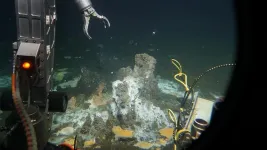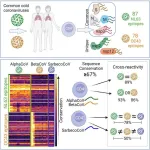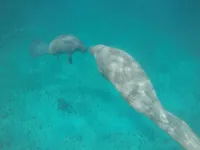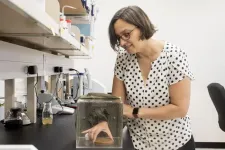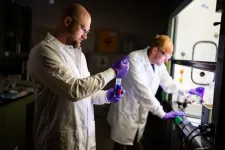(Press-News.org) Microbial communities are especially active near hydrothermal seeps like those in the Guaymas Basin in the Gulf of California. The team of researchers has been working on understanding these communities for many years. Organic material deposited in the Guaymas Basin is cooked by heat sources from within the Earth, which breaks it down into crude oil and natural gas. Their components provide the primary source of energy for microorganisms in an otherwise hostile environment. In their latest study, the researchers have demonstrated that archaea use a previously unknown mechanism to degrade liquid petroleum alkanes at high temperatures without the presence of oxygen.
Alkanes are highly stable compounds of carbon and hydrogen. They are natural components of natural gas and crude oil. The latter is refined by humans into fuels like gasoline and kerosene. Environmental catastrophes occur repeatedly due to accidents during the extraction of crude oil. A prime example was the accident on the Deepwater Horizon drilling platform, which caused severe environmental damage in the Gulf of Mexico due to the toxic effects of crude oil compounds like liquid alkanes. In the presence of oxygen, microorganisms can rapidly break down many components of crude oil, among others alkanes. Without the reactive oxygen, however, degradation is considerably more difficult. Organisms that can perform this task have not been extensively researched. In recent years, however, evidence has been found that archaea are able to employ a surprising mechanism to do this. It is based on newly discovered variants of the key enzyme of methanogenesis and anaerobic methane degradation, methyl-coenzyme M reductase (MCR). The genes that encode these enzymes have been found in many environmental samples. However, laboratory cultures of the microbes that could illustrate the function of these enzymes were still lacking. This is where the laboratory study of Hanna Zehnle and her colleagues becomes significant.
The team used sediments from the 2000-meter-deep Guaymas Basin in the Gulf of California. The special geological conditions that exist here include high temperatures, liquid crude-oil components, and an anaerobic environment at shallow sediment depths, all of which are normally only found in deep-lying oil reservoirs which are difficult for scientists to access.
In the Bremen laboratories the researchers prepared cultures with liquid alkanes and allowed them to grow anaerobically, i.e., without oxygen, at high temperatures (70 degrees Celsius). “After a time,” explains first author Hanna Zehnle, “sulfide forms in the cultures. This provides evidence that they are active.” The composition of the cultures is studied using DNA and RNA samples. “With this method we can find out what organisms are living in this system and which metabolic pathways they are using,” says Zehnle. These include the chemical reactions in which substances are metabolized. They found archaea of the genus Candidatus Alkanophaga in the cultures. These archaea use variants of the MCR for breaking down the alkanes. The researchers verified this by transcriptome data, measurement of the enzyme products, and by demonstrating inactivity of the cultures when the enzyme was inhibited. But the organisms are not able to degrade the crude oil alone. Respiration, in the form of sulfate reduction in this case (because no oxygen is present), is carried out by bacteria of the genus Thermodesulfobacterium, which form dense consortia with the archaea.
Methanogenesis is one of the oldest known metabolic processes and is a part of the global carbon cycle. The laboratory study by Hanna Zehnle and her colleagues shows that the enzymes involved in this process can also utilize liquid (and thus toxic) hydrocarbons which highlights the relevance of this pathway for the global carbon cycle.
“Thanks to their newly discovered capabilities, Alkanophaga and their relatives are targeting hydrocarbons in oil reservoirs. The remaining oil becomes more and more solid and therefore tends to remain in the seafloor,” explains corresponding author Gunter Wegener. “We still have not been able to investigate any deep oil reservoirs, but the archaea are certainly annoying the oil industry with their activity. But they also make an important contribution to the fact that natural oil seeps are rare.”
This study is a part of the research within the Cluster of Excellence “The Ocean Floor – Earth’s Uncharted Interface”, which is housed at MARUM. Among other research areas, investigations are being conducted here to determine which microorganisms and environmental conditions provide the ocean floor with the qualities required to function as a reactor that has been balancing the Earth's carbon cycle since time immemorial. Questions relating to what the organisms in the deep biosphere in higher temperature ranges live from is one of the core themes of the Cluster.
Participating Institutes:
MARUM – Center for Marine Environmental Sciences at the University of Bremen, Bremen, Germany
Max Planck Institute for Marine Microbiology, Bremen, Germany
Faculty of Geosciences, University of Bremen, Bremen, Germany
Department of Systems Biology, National Centre for Biotechnology – CSIC, Madrid, Spain
Max Planck Institute for Multidisciplinary Sciences, Göttingen, Germany
Department of Earth, Marine and Environmental Sciences, University of North Carolina at Chapel Hill, NC, USA
MARUM produces fundamental scientific knowledge about the role of the ocean and the seafloor in the total Earth system. The dynamics of the oceans and the seabed significantly impact the entire Earth system through the interaction of geological, physical, biological and chemical processes. These influence both the climate and the global carbon cycle, resulting in the creation of unique biological systems. MARUM is committed to fundamental and unbiased research in the interests of society, the marine environment, and in accordance with the sustainability goals of the United Nations. It publishes its quality-assured scientific data to make it publicly available. MARUM informs the public about new discoveries in the marine environment and provides practical knowledge through its dialogue with society. MARUM cooperation with companies and industrial partners is carried out in accordance with its goal of protecting the marine environment.
END
Bremen researchers cultivate archaea that break down crude oil in novel ways
How microorganisms deep in the seabed render crude oil harmless
2023-06-01
ELSE PRESS RELEASES FROM THIS DATE:
Owkin powers a new era in oncology research with MOSAIC – an unprecedented $50 million spatial atlas of cancer cells
2023-06-01
– Cutting-edge spatial omics technologies to map cancer cells and their immune environment in high resolution, allowing AI to unlock potential for new breakthrough treatments –
– Landmark research project is 100x larger than existing efforts –
– Data will be generated from thousands of patients across multiple cancers –
– University of Pittsburgh, Gustave Roussy, Lausanne University Hospital, Uniklinikum Erlangen/Friedrich-Alexander-Universität Erlangen-Nürnberg , Charité ...
Adolescents are aware of and invested in the potential impacts of abortion restrictions, study says
2023-06-01
CHAPEL HILL, N.C. – On July 1, North Carolina’s new abortion limits go into effect. As restrictions on abortions are being tightened across the United States, adolescents may encounter mounting obstacles that could prevent them from accessing abortion care.
Bianca A. Allison, MD MPH, an assistant professor in the Department of Pediatrics, sought to examine the awareness and knowledge that adolescents have about the legal landscape of abortion and how these changes might affect them and their communities.
The study, published in the Journal of Adolescent Health, found that many adolescents – across a diversity of ...
Family resemblance: How T cells could fight many coronaviruses at once
2023-06-01
LA JOLLA, CA—Scientists at La Jolla Institute for Immunology (LJI) are investigating how the immune system's T cells react to a wide variety of coronaviruses, ranging from SARS to common cold coronaviruses. Their goal is to guide the development of vaccines that could halt future pandemic by combatting many types of coronaviruses at once.
"While it was recognized that coronaviruses were potentially dangerous viruses, because of SARSCoV and MERS viruses causing very severe disease in humans, nobody knew that the next pandemic was going to be caused by SARS-CoV-2," says LJI Professor Alessandro Sette, Dr.Biol.Sci. ...
New UNC study quantifies disparity among minority communities exposed to traffic-related air pollution across the U.S.
2023-06-01
Traffic-related air pollution is a pervasive problem across the United States. Vehicle emissions are highest near major roadways with around 19% of the U.S. population living in the vicinity of a major roadway. In more densely populated states, like California, up to 40% live near a major roadway. Exposure to these pollutants, such as fine particulate matter (PM2.5 ) and nitrogen dioxide (NO2), a byproduct of burning fossil fuel, can lead to a host of health effects including premature death. Minority communities often live along these corridors and experience disproportionate exposures.
A ...
Study identifies boat strikes as a growing cause of manatee deaths in Belize
2023-06-01
The endangered Antillean manatee faces a growing threat from boat strikes in Belize, according to a new study that raises concerns about the survival of what had been considered a relatively healthy population.
Belize hosts a population of around 1,000 manatees. With the growth of tourism in recent decades, however, Belize has seen a substantial increase in boat traffic, making boat strikes an increasingly important cause of manatee deaths and injuries.
The new study, published June 1 in Endangered Species Research, used 25 years of data on manatee strandings (dead or injured ...
Biologists to create ‘toolbox’ for understanding complex genetic traits
2023-06-01
Driven by a lifelong curiosity about the natural world and the diversity of life, Elizabeth King, associate professor in the Division of Biological Sciences at the University of Missouri, found inspiration to spend her formative years studying science — and along the way she discovered her passion for biology. That foundation has led her to pursue an ongoing career working to develop a better understanding of genetic traits from a biological perspective.
Recently, the National Institutes of Health (NIH) awarded King a five-year, $1.9 million grant to expand her lab’s research ...
Salton Sea environment detrimental to respiratory health of local children
2023-06-01
RIVERSIDE, Calif. -- In the United States, low-income immigrant and minority children often live in environments that have highly polluted air. A study led by researchers at the University of California, Riverside, demonstrates this among the Latinx and Purépecha immigrant children and caregivers living along Inland Southern California’s Salton Sea, a highly saline drying lakebed surrounded by agricultural fields. The Purépecha community is an Indigenous group from the Mexican state of Michoacán.
“Children of Latinx ...
Fellowship offers reporters valuable insight as America ages
2023-06-01
The Gerontological Society of America (GSA) has received renewed grant support to welcome a new class of reporters for the Journalists in Aging Fellows Program. The 2023 funders to date include Silver Century Foundation, The John A. Hartford Foundation, Archstone Foundation, and NIHCM Foundation.
Since its founding in 2010, this program has been responsible for more than 800 news stories produced by 217 alumni. It has two goals: to educate journalists about issues in aging, better allowing them to spread a new awareness to general-audience, ethnic, and other minority populations; ...
Critical decision-3A clears way toward standard model test
2023-06-01
NEWPORT NEWS, VA – The U.S. Department of Energy has given the greenlight for the MOLLER experiment to begin procurement of key components with its granting of Critical Decision-3A (CD-3A): Approve Long Lead Procurements. The determination allows the MOLLER project at DOE’s Thomas Jefferson National Accelerator Facility to begin spending $9.14 million for long-lead procurements of critical items for which designs are complete.
After imagining what it would look like for 17 years, Krishna Kumar felt chills the first time he saw fully engineered drawings of the MOLLER experiment.
“Seeing the designs on paper gave me pins and needles,” said Kumar, professor of ...
Sandia scientists achieve breakthrough in tackling PFAS contamination
2023-06-01
ALBUQUERQUE, N.M. — A team at Sandia National Laboratories is developing materials to tackle what has become one of the biggest problems in the world: human exposure to a group of chemicals known as PFAS through contaminated water and other products. Sandia is now investing more money to take their research to the next level.
“It’s in the news constantly. It seems every day we hear of another product that is contaminated. We saw sparkling water with PFAS, toilet paper with PFAS, so it’s ...
LAST 30 PRESS RELEASES:
Making lighter work of calculating fluid and heat flow
Normalizing blood sugar can halve heart attack risk
Lowering blood sugar cuts heart attack risk in people with prediabetes
Study links genetic variants to risk of blinding eye disease in premature infants
Non-opioid ‘pain sponge’ therapy halts cartilage degeneration and relieves chronic pain
AI can pick up cultural values by mimicking how kids learn
China’s ecological redlines offer fast track to 30 x 30 global conservation goal
Invisible indoor threats: emerging household contaminants and their growing risks to human health
Adding antibody treatment to chemo boosts outcomes for children with rare cancer
Germline pathogenic variants among women without a history of breast cancer
Tanning beds triple melanoma risk, potentially causing broad DNA damage
Unique bond identified as key to viral infection speed
Indoor tanning makes youthful skin much older on a genetic level
Mouse model sheds new light on the causes and potential solutions to human GI problems linked to muscular dystrophy
The Journal of Nuclear Medicine ahead-of-print tip sheet: December 12, 2025
Smarter tools for peering into the microscopic world
Applications open for funding to conduct research in the Kinsey Institute archives
Global measure underestimates the severity of food insecurity
Child survivors of critical illness are missing out on timely follow up care
Risk-based vs annual breast cancer screening / the WISDOM randomized clinical trial
University of Toronto launches Electric Vehicle Innovation Ontario to accelerate advanced EV technologies and build Canada’s innovation advantage
Early relapse predicts poor outcomes in aggressive blood cancer
American College of Lifestyle Medicine applauds two CMS models aligned with lifestyle medicine practice and reimbursement
Clinical trial finds cannabis use not a barrier to quitting nicotine vaping
Supplemental nutrition assistance program policies and food insecurity
Switching immune cells to “night mode” could limit damage after a heart attack, study suggests
URI-based Global RIghts Project report spotlights continued troubling trends in worldwide inhumane treatment
Neutrophils are less aggressive at night, explaining why nighttime heart attacks cause less damage than daytime events
Menopausal hormone therapy may not pose breast cancer risk for women with BRCA mutations
Mobile health tool may improve quality of life for adolescent and young adult breast cancer survivors
[Press-News.org] Bremen researchers cultivate archaea that break down crude oil in novel waysHow microorganisms deep in the seabed render crude oil harmless
